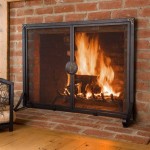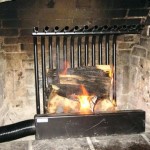Replacing a Wood Stove with an Electric Fireplace: A Comprehensive Guide
The decision to transition from a wood stove to an electric fireplace involves considering various factors, including heating efficiency, environmental impact, convenience, and aesthetics. Both options offer warmth and ambiance, but they differ significantly in their operational characteristics and long-term implications. This article provides a detailed analysis of the considerations involved in replacing a wood stove with an electric fireplace, offering insights into the advantages and disadvantages of each system to facilitate informed decision-making.
Wood stoves have been a traditional heating source for centuries, providing localized warmth and a rustic aesthetic. They rely on the combustion of wood, a potentially renewable resource, to generate heat. However, wood stoves also present challenges, including air pollution, the need for manual tending, and the requirement for a dedicated chimney or flue. Electric fireplaces, on the other hand, offer a more modern and convenient alternative. They utilize electricity to produce heat and often incorporate realistic flame effects to mimic the appearance of a traditional fireplace. The choice between these two heating systems hinges on individual needs, priorities, and circumstances.
Understanding the Environmental Impact
One of the most significant considerations when comparing wood stoves and electric fireplaces is their environmental impact. Wood stoves, even newer models with improved efficiency, release particulate matter and other pollutants into the atmosphere. These emissions contribute to air pollution, which can have adverse effects on respiratory health and the environment. The burning of wood also releases carbon dioxide, a greenhouse gas that contributes to climate change. While wood is often considered a renewable resource, its sustainability depends on responsible forestry practices and the rate of replenishment.
Electric fireplaces, in contrast, do not directly produce emissions. Their environmental impact is primarily determined by the source of electricity used to power them. If the electricity is generated from renewable sources, such as solar or wind power, the environmental footprint of an electric fireplace is significantly lower than that of a wood stove. However, if the electricity is generated from fossil fuels, the environmental impact may be comparable or even greater, depending on the efficiency of the power plant and the overall energy mix of the region. To accurately assess the environmental impact of using an electric fireplace, it is crucial to consider the energy source and its associated environmental consequences.
Furthermore, the manufacturing process of both wood stoves and electric fireplaces contributes to their overall environmental impact. The extraction of raw materials, the manufacturing of components, and the transportation of finished products all require energy and resources. While it is difficult to quantify the exact environmental impact of each system without a comprehensive life-cycle assessment, it is important to recognize that both options have environmental implications that should be considered.
Evaluating Heating Efficiency and Cost
Heating efficiency and cost are key factors in deciding between a wood stove and an electric fireplace. Wood stoves typically have a lower thermal efficiency than electric fireplaces. A significant portion of the heat generated by a wood stove is lost through the chimney or flue. This inefficiency can result in higher fuel consumption and increased heating costs over time. The actual efficiency of a wood stove depends on several factors, including the design of the stove, the quality of the wood, and the skill of the operator.
Electric fireplaces are generally more efficient in converting electricity into heat. They utilize resistance heating elements or infrared technology to produce warmth, and most of the energy is directly transferred to the room. However, the overall cost of heating with an electric fireplace depends on the price of electricity in the region. In areas with high electricity rates, heating with an electric fireplace may be more expensive than heating with a wood stove, especially if wood is readily available and affordable.
In addition to fuel costs, the initial investment in each system should be considered. Wood stoves require professional installation, including the installation of a chimney or flue if one is not already present. This can add significantly to the overall cost. Electric fireplaces are generally easier to install, often requiring only plugging into a standard electrical outlet. However, the cost of the electric fireplace itself can vary widely depending on the features and design. A thorough cost-benefit analysis, considering both upfront costs and long-term operating expenses, is essential for making an informed decision.
The heating capacity of both systems should also be evaluated. Wood stoves are capable of producing a large amount of heat, making them suitable for heating large spaces. Electric fireplaces, on the other hand, typically have a lower heating capacity and are better suited for supplemental heating or heating smaller areas. The appropriate size and heating capacity of the chosen system should be determined based on the size of the space to be heated and the desired level of warmth.
Assessing Convenience and Maintenance
Convenience and maintenance are important considerations for homeowners when choosing a heating system. Wood stoves require a significant amount of manual labor. This includes sourcing, storing, and loading wood; tending the fire; and regularly cleaning the stove and chimney. The ash produced by wood stoves must also be disposed of properly. These tasks can be time-consuming and physically demanding, making wood stoves a less convenient option for some homeowners.
Electric fireplaces offer a much higher level of convenience. They require minimal maintenance and can be easily operated with a remote control or thermostat. There is no need to source or store fuel, and there is no ash to dispose of. Electric fireplaces also eliminate the risk of carbon monoxide poisoning, which is a potential hazard associated with wood stoves. The ease of use and low maintenance requirements make electric fireplaces a more attractive option for many homeowners.
However, it is important to note that electric fireplaces rely on a consistent power supply. In the event of a power outage, an electric fireplace will not function, leaving the homeowner without a heating source. Wood stoves, on the other hand, can provide heat even during a power outage, making them a more reliable option in areas prone to power disruptions. Considerations should be made based on the dependability of local power infrastructure.
The installation process also affects convenience. Installing a wood stove requires adherence to building codes and safety regulations. Professional installation is often required to ensure proper ventilation and prevent fire hazards. Electric fireplaces, conversely, are typically easier to install and may not require professional assistance. This simplified installation process can save time and money, making electric fireplaces a more convenient option for some homeowners.
Safety is another important aspect of convenience. Wood stoves can pose a fire hazard if not properly maintained or operated. Creosote buildup in the chimney can lead to chimney fires, and sparks from the firebox can ignite nearby flammable materials. Electric fireplaces are generally considered safer than wood stoves, as they do not produce open flames or sparks. This reduced risk of fire can provide peace of mind for homeowners, particularly those with young children or pets.
Exploring Aesthetic and Design Options
The aesthetic appeal of a heating system is often a significant factor in the decision-making process. Wood stoves offer a rustic and traditional aesthetic, with the visible flames and crackling sounds creating a cozy ambiance. They can be a focal point in a room, adding character and charm to the decor. However, the appearance of a wood stove may not be compatible with all interior design styles.
Electric fireplaces offer a wider range of aesthetic and design options. They are available in various styles, from traditional to contemporary, and can be customized to match the existing decor. Electric fireplaces can be installed in walls, on mantels, or as freestanding units, providing flexibility in placement and design. Many electric fireplaces also feature realistic flame effects, which mimic the appearance of a traditional fire without the associated risks or maintenance.
Furthermore, electric fireplaces often include additional features that enhance their aesthetic appeal. These features may include adjustable flame colors, brightness settings, and built-in lighting. These customizable options allow homeowners to create the desired ambiance and mood in the room. Some electric fireplaces also include built-in speakers, which can play crackling fire sounds to further enhance the realism of the experience.
The visual appeal of the surrounding area should also be considered. Wood stoves require a designated area for storing wood, which can detract from the overall aesthetic of the room. Electric fireplaces, on the other hand, do not require fuel storage and can be seamlessly integrated into the existing decor. This can result in a cleaner and more visually appealing living space.
Ultimately, the choice between a wood stove and an electric fireplace depends on individual preferences and priorities. Homeowners who value the traditional aesthetic and the warmth of a real fire may prefer a wood stove. Those who prioritize convenience, safety, and design flexibility may find an electric fireplace to be a more suitable option. Careful consideration of these factors will help homeowners make an informed decision that aligns with their needs and preferences.

How To Convert Your Wood Burning Fireplace Electric Or Gas

Wood Burning To Electric Fireplace Conversion
Electric Fireplace Basics Heat Glo

Fireplace Fix Easy Tips To Renovate Retrofit And Replace An Old Fire Touchstone Home S Inc
How To Install An Electric Fireplace Insert

Converting A Fireplace To Wood Burning Stove Chesneys

Do Electric Fires Just Plug In Direct Fireplaces

Converting A Fireplace To Wood Burning Stove Chesneys

How To Install An Electric Fireplace Insert Step By Guide

Fireplace Inserts Everything You Need To Know Full Service Chimney
Related Posts








